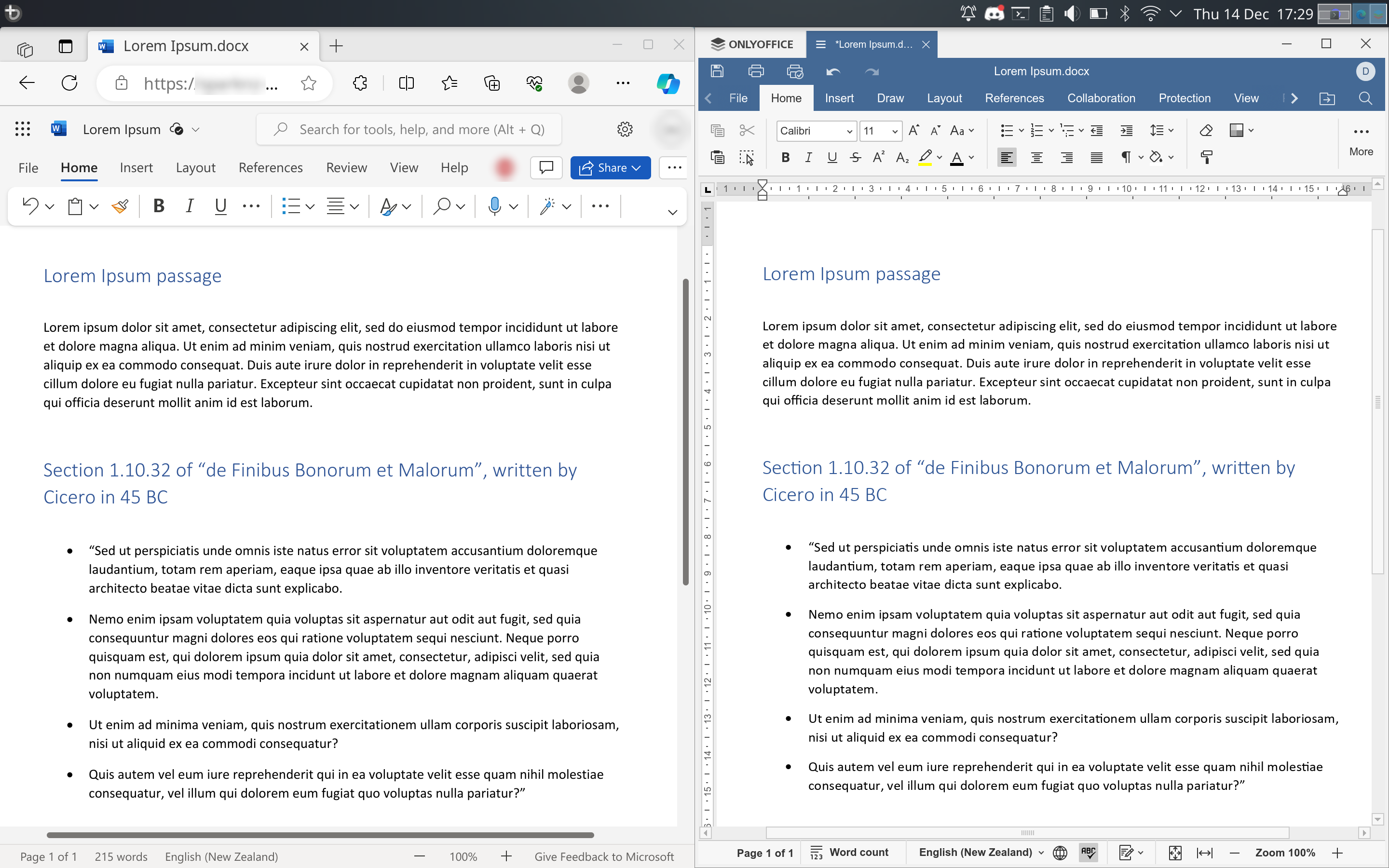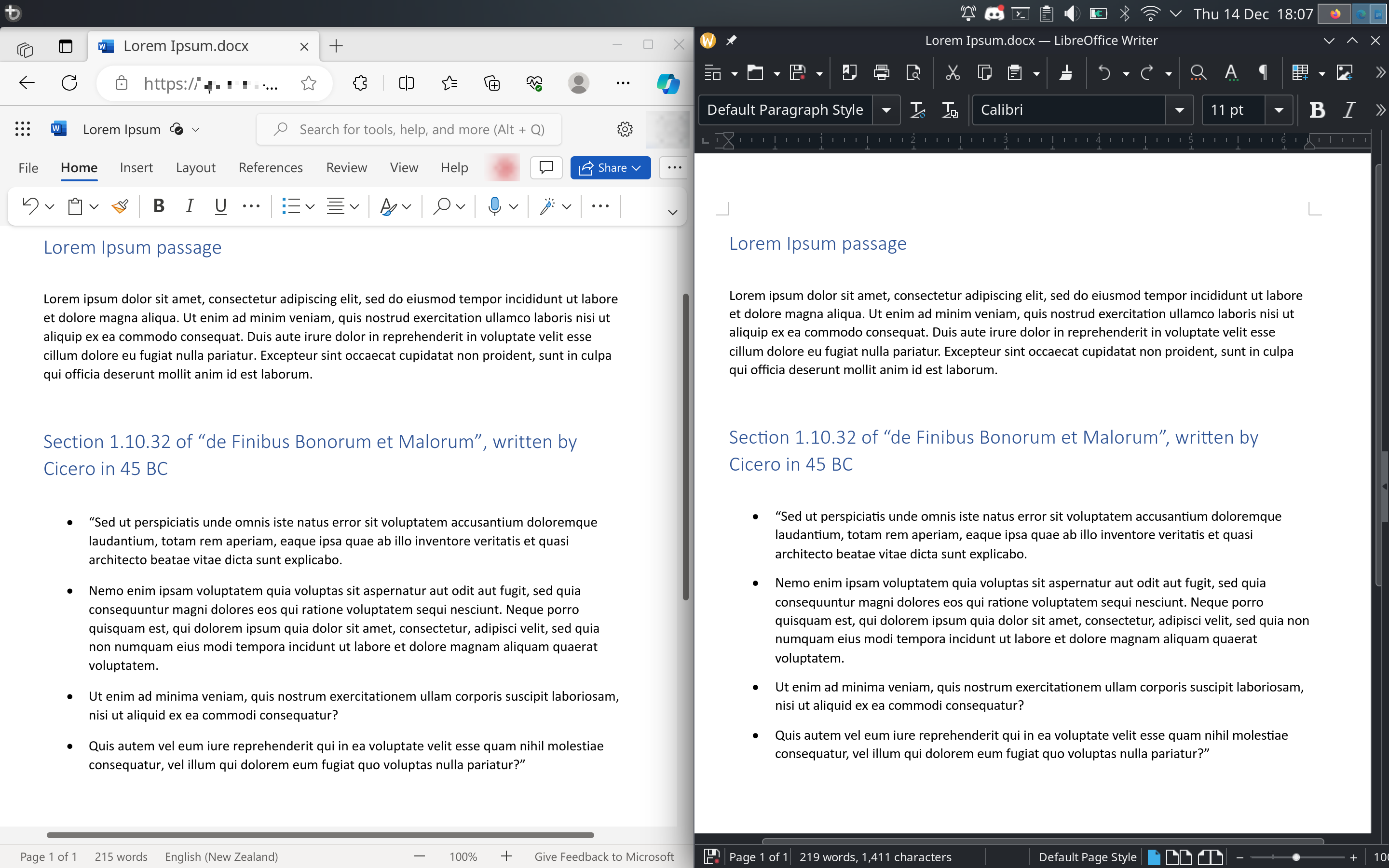Um... that's NOT a refusal, it's just a warning. Clicking on that highlighted button will save the DOCX.
To not get the warning again, all you have to do is untick the checkbox which says "ask when not saving on ODF" - it's there right in your screenshot.
Yes, I believe so. It used to be "experimental" back in the day, not sure of its current status though.
Yes, it should work with any RDP client. And Remmina actually uses Freerdp as the backend btw. :)
Yes, you can indeed install them in Windows as well. sfreerdp is the main server binary, and wfreerdp is the main client.
Here's a full explanation of what each file does:
-
freerdp-proxy.exe: This executable is a proxy server for RDP sessions. It's used to forward, or 'proxy', RDP traffic between a client and a server. This can be useful for security, auditing, or network architectural reasons.
-
sdl-freerdp.exe: This binary is a version of the FreeRDP client that uses the Simple DirectMedia Layer (SDL) for its graphical output. SDL is a cross-platform development library designed to provide low-level access to audio, keyboard, mouse, joystick, and graphics hardware. This makes sdl-freerdp.exe useful for systems where a lightweight or more compatible graphical output method is needed.
-
sfreerdp-server.exe: This is the server component of the FreeRDP project. It allows a Windows machine to act as an RDP server, accepting connections from RDP clients. This can be particularly useful for testing or for setting up remote desktop services on systems where a full-fledged RDP server isn't available or desired.
-
wfreerdp.exe: This executable is the standard FreeRDP client for Windows. It's used to connect to RDP servers from a Windows machine. It provides a wide range of features and options typical of RDP clients, such as support for different color depths, audio redirection, and file system redirection.
-
winpr-hash.exe: This tool is part of the Windows Portable Runtime (WinPR) library, which is a part of FreeRDP. It's used to create a NTLM hash from a username and password pair. The created hash can be outputed as plain hash or in SAM format.
-
winpr-makecert.exe: Also part of WinPR, this executable is used to create certificates. Certificates are crucial in secure communications, such as those used in RDP sessions. They are used to establish trust and encrypt data. This tool can be used to generate certificates for testing or for specific secure communication requirements within the RDP framework.
Firstly, there's no guarantee that a document would look exactly the same even within different versions of MS Office itself. Also, try opening any complex document in MS Office on macOS for instance, and you'll most likely notice issues or differences compared to the Windows version. In my old sysadmin job, where I used a Mac, we had a standard "change control" template that we had to fill out when doing infrastructure changes, and the radio buttons used in the form didn't work on the macOS version of Office. So issues like this are pretty common. These sort of issues are why people either normally ignore them OR in the case that layout/formatting is critical (eg: for publishing/printing), then they'd use PDF or TeX or similar formats, where the formatting is preserved.
Secondly, as @[email protected] mentioned, use OnlyOffice if MSO compatibility is important. Below is a screenshot I captured of a recreated Lorem Ipsum docx on my Linux machine, with MS Office Online (running on Edge) on the left and OnlyOffice on the right.

As you can see, they're virtually identical - and any difference in the sizing etc would come down to the fact that I'm running the web version of MSO, so the zoom/scaling may not exactly match that of OO. But other than that, if you check the spacing and everything else, it's pretty accurate.
Finally, in saying that, even OO has it's limitations and isn't a 100% replacement for MSO - as it can't run macros, or may not be able to display certain types of embedded objects in Excel and so on. But then, even the web and Mac versions of MS Office has these sort of limitations. But the average home user wouldn't normally use macros or advanced features in Office, so for the most part, OO, or even LO should be fine for most users.
Also, just as a reminder, in this thread we're discussing about how Linux can work fine for most home users, the kind of users who have simple requirements, and aren't dependent on specific proprietary programs like Photoshop etc. Obviously Linux will not be suitable for every single need or use case out there, but neither is Windows or MacOS - if you have special needs or requirements, then use the tool that's best for the job. But nitpicking minor differences like this isn't helping anyone, we'd be sitting here arguing all day about how "X OS sucks because it can't do Y", which is a pointless exercise.
Edit: I was curious to see how bad LibreOffice actually was so I just tested it out:

... and that was surprisingly not bad at all! Just one word out of place. But this goes to show how opensource software is ever evolving and constantly improving - so a particular criticisms you may have had in the past may no longer be applicable, unless you test it out yourself against the latest versions.
Yes, but the whole point of using Opal2 encryption is that you don't need to use OS-level FDE/filesystem encryption, thus simplifying your set up.
Of course, you can still use them if you want to though.
Same here. Not just my parents, but also some of my aunts and uncles. None of them are particularly tech savvy and none of them have had any major issues.
People who claim that Linux is difficult to use, or not suitable for newbies, have no idea what they're talking about.
ThinkPad P14s AMD Gen 1
Both the laptop and the stock NVMe drive supports Opal2. Not sure about your second drive but if it also supports Opal2, then you should just use that instead of ZFS encryption, since Opal encryption is transparent to the OS, so you won't have any issues with hibernation.
I'd wager that it's your scheduler. Prior to the latest kernel release (v6.6), Linux used the CFS scheduler which is outdated and not really optimal for desktop usage. As a result, many third-party alternate schedulers were developed to fix this issue, with the most recent popular ones being the System76 scheduler (used in Pop!_OS), and BORE (used in CachyOS). But this issue has been solved officially now, with the EEVDF scheduler (earliest eligible virtual deadline first scheduling), which has finally replaced CFS.
So if you're not on 6.6, upgrade to it, or use the System76 scheduler. Also switch to Wayland if you haven't already and you'll notice your Linux desktop just as smooth, if not smoother, than Windows.
I have an M1 MacBook Air and a Thinkpad Z13 G1 (running Bazzite KDE with kernel 6.6.3 + System76 scheduler), and comparing the touchpad gestures and window animations side-by-side - especially the gestures and animation to switch workspaces - it's just as smooth as macOS (at least to my eyes), and that's quite the feat given that macOS has been the king of smooth animations and responsiveness for a long time.
For a macOS-like environment I'd also recommend Elementary OS.